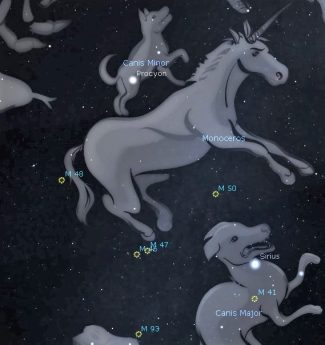This Week’s Sky at a Glance, 2024 Jan. 20 – Jan. 27
This Week’s Sky at a Glance, 2024 Jan. 20 – Jan. 27
Monoceros is a constellation that is easy to locate, sandwiched between Orion’s dogs Canis Major and Canis Minor, but it is not easy to see. From urban areas its dim stars are as elusive as the unicorn they depict. It was one of eight new constellations created on a globe by the Dutch cartographer Petrus Plancius around 1612. Of those eight, only Monoceros and Camelopardalis are recognized as official constellations today. Monoceros is situated within the winter Milky Way, which is apparent in rural skies.
Despite being a dim constellation, Monoceros is home to some favourite targets of astrophotographers, in particular the beautiful Rosette Nebula. Another is the combination of the Cone Nebula, Christmas Tree Cluster and the Fox Fur Nebula. Check the Internet for their stunning images. Monoceros has one Messier object within its boundary, the large open cluster M50, otherwise known as the Heart-Shaped Cluster. It can be seen in binoculars about 40% of the distance from Sirius to Procyon. Three other open clusters on the Messier list are found near Monoceros but they lie officially within other constellations. They are the close pair of M46 and M47 in Puppis, and M48 in Hydra.
This Week in the Solar System
Saturday’s sunrise in Moncton is at 7:54 and sunset will occur at 5:06, giving 9 hours, 12 minutes of daylight (7:56 and 5:13 in Saint John). Next Saturday the Sun will rise at 7:47 and set at 5:16, giving 9 hours, 29 minutes of daylight (7:50 and 5:23 in Saint John).
The Moon is near the Pleiades cluster in Taurus this Saturday evening, below Pollux in Gemini on Wednesday, and it is full on Thursday. On Monday telescope users might see Jupiter’s moon Europa disappear behind the planet at 5:50, reappear on the other side at 8:14, disappear into shadow 22 minutes later and reappear at 10:58, while Io reappears from Jupiter’s shadow at 8:32. Saturn sets around 8 pm midweek so observe it early. Mercury is speeding eastward from Venus toward a difficult-to-observe, tight meet-up with Mars next Saturday morning. For those who need an excuse to party on weekends, Pluto is in conjunction with the Sun this Saturday and Uranus is stationary next Saturday.
On Sunday evening at 8 pm, tune in to 200th episode of the Sunday Night Astronomy Show via the Facebook page or YouTube channel of Astronomy by the Bay.

